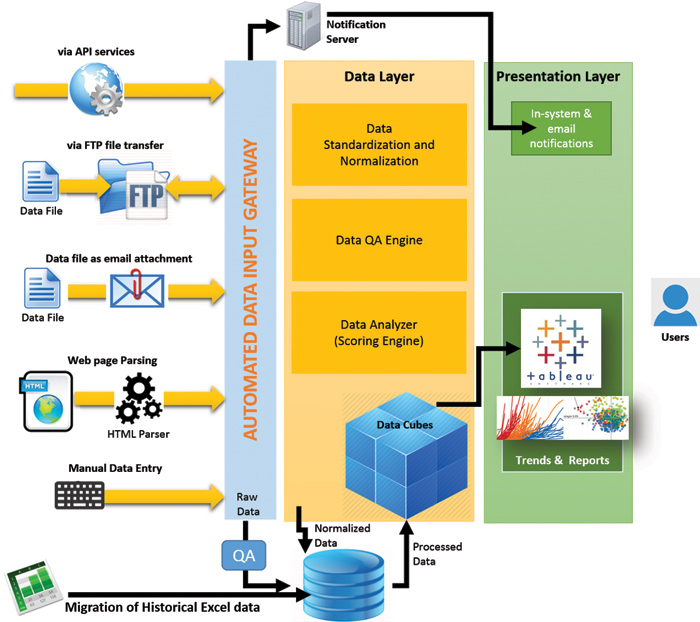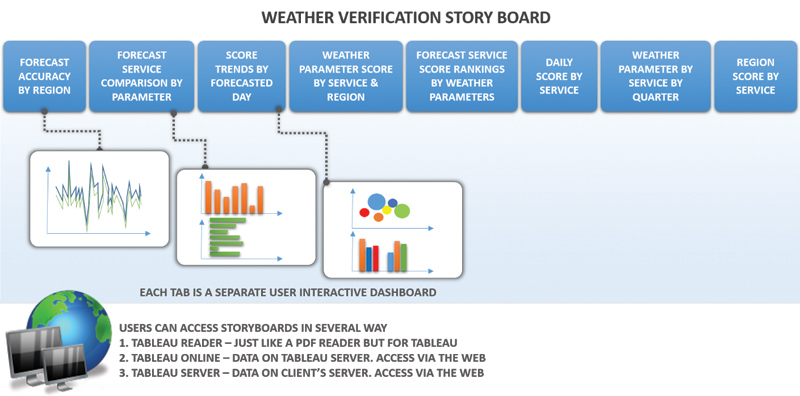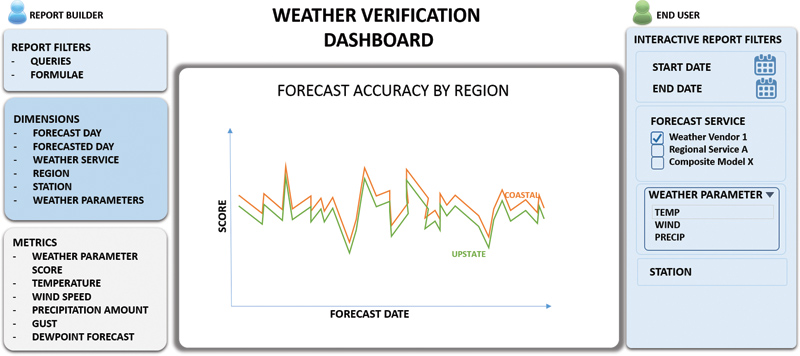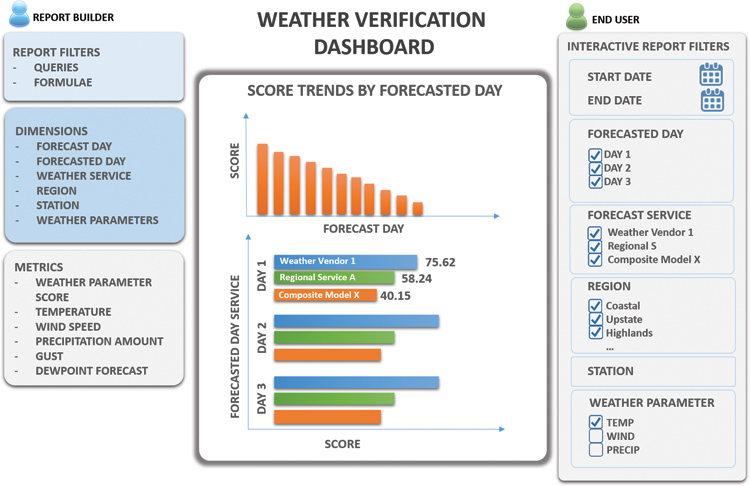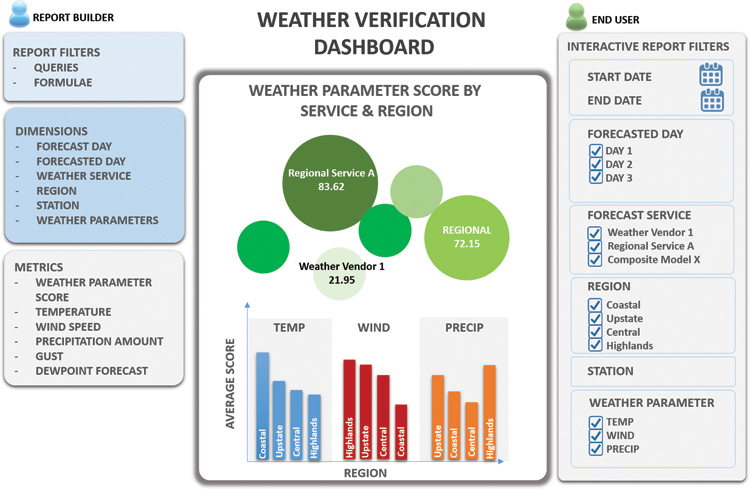INTRODUCTION TO MINE-WEATHER
Overview
Mine-Weather is an analytical database and visualization system designed to allow companies to probe the accuracy of the weather forecasts they use to plan their activities and preparedness in the case of storm conditions. The tool captures and stores both weather forecast data and observational data for all stations within a given geographical area.
The data is saved at hourly intervals and can be stored for several years, allowing analysis of different types of weather events over a long period of time. As an initial step in the configuration of the system for a specific client, existing historical data can be uploaded.
Background
Weather forecast data play a central role in preparedness and capacity planning for various companies and governmental entities, including electric and gas utilities, transportation companies and transit government entities, investment firms interested in understanding the relationship between a company’s infrastructure and their service capabilities under different weather conditions.
THERE IS LITTLE INDEPENDENT EVALUATIONS OF HOW GOOD SPECIFIC WEATHER FORECASTS ARE IN THE FACE OF DIFFERENT TYPE OF WEATHER EVENTS IMPORTANT TO A SPECIFIC COMPANY
Many of these companies have a critical need to know the forecast or how bad the weather will be 1-3 days out, 3-5 days out and in some cases even longer time horizons are important, out as far as 10 days.
Weather forecast services provide the information companies use in their internal planning exercises. But generally there is little independent evaluations of how good specific weather forecasts are in the face of different type of weather events important to a specific company.
Mine-Weather provides the framework for companies to perform their own independent analysis on the accuracy of weather forecasts they rely on, and to do that evaluation for the specific types of weather events that are most important to the client. We give examples of those types of weather events below.
So the critical issue is not what the overall weather forecast accuracy over a season/year, but rather how good is the weather forecast data for the event types most important to a specific company. The data quality of the forecast for a specific weather variable and within certain ranges of a weather variable (for example for wind speeds above 20 mph only).
Mine-Weather allows clients to segment out the specific time periods and weather variables of interest. They can then probe the accuracy of the forecasts for these specific segments. Since the data is all stored in a deep analytical data zone, these segments can be re-defined as often as needed to answer the important questions of the day.
Applications
The Mine-Weather system provides an analytical data zone for evaluation and verification of weather forecasts for many critical needs.
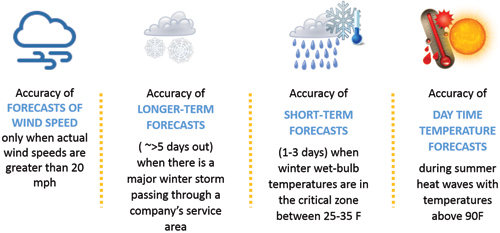
There are a myriad of other applications depending on the company’s specific need. Upon detailed analyses, companies will gain insight on specific usage of forecast data may be inappropriate or detrimental since they may find that the accuracy of the data is just not good enough to be useful.
Companies need a flexible analytical data zone for independently probing the accuracy of their current forecasts in all of these situations, and for quickly visualizing the data and results and preparing a report for manager’s review.
MINE-WEATHER PROVIDES THE FIRST CLOUD-BASED PLATFORM FOR PERFORMING CRITICAL FORECAST ANALYSES.
Infrastructure
Mine-Weather is a cloud-base application, residing entirely in a Microsoft Azure private cloud arrangement we set up for each client. So the entire capability of Mine-Weather is accessible to a company via an analyst’s PC. The private cloud arrangement provides high levels of security and reliability for both the data as well as the analytical framework that is used to store the many different analyses performed by a client.
Mine-Weather is flexible to accommodate client needs and to allow for significant upsurges in usage during certain periods of time. Costs for the service are usage-based.
Macrosoft will work with a client to implement automated processes for capturing all of the weather variables provided in a client’s weather forecast services, including capturing the text data that may be included with each forecast. We can utilize text parsing programs for selecting and interpreting information from the text. We capture all the individual forecast provided each day.
Mine-weather data inputs include individual forecasts with 1-4 ‘future’ days of hourly-level forecasts followed by 4-6 ‘future’ days of daily forecasts.
Likewise, we capture all the observation weather data from all the stations in the client’s service area. Again, we work with the client to set up automated processes for ingesting all of the actual data. Normally this data is input on an hourly level.
Most forecasts include a wide range of weather variables at different levels of granularity, and we strongly recommend linking them all to Mine-Weather. The ones of particular interest will likely change over time, and having them all in the data base from the start, makes them all available to the client down the road.
Start-up Process
Working with a client, the company develops automated upload processes for interfacing all of the client’s current data forecasts and actual observational data from all the stations available to the client. Additional forecasts and stations can be added easily at any point in time. Raw data is saved in the data store, and is always available for later analyses as new questions and issues arise. Mine-Weather system’s strategic benefit is that all of the client’s weather forecast and actual data is for analysis at all times.
A NUMBER OF STANDARD SCORING MODELS ARE ALREADY AVAILABLE WITHIN MINE-WEATHER
Macrosoft works with the client to implement a ‘starter set’ of scoring models they are interested in for evaluating their weather forecasts. A number of standard scoring models are already available within Mine-Weather, so clients can start with that set.
THE COMPANY WORKS CLOSELY WITH THE CLIENT TO MAKE SURE
THE DATA PROVIDED IN THE FEEDS IS NOT ‘OVER-INTERPRETED’ OR
‘OVER-EXTENDED’
New models may involve selecting the specific new weather variables needed for scoring, and the specific scoring formulas. Since all of the data in the input forecast and observation feeds are already linked to the system in the back-end, the only new work involved is to drawn that new additional weather variable into the analytical framework section of the system. Then, based on this information, we implement a process for creating new summary tables of the weather variables of interest and the scores associated with them. There may be multiple summary tables generated for viewing the data.
The firm works closely with the client to make sure the data provided in the feeds is not ‘over-interpreted’ or ‘over-extended’, that is we recommend to never add data where it does not exist. For example, if forecast data is available only on a 6-hour time frame, we recommend only comparing the forecast with the actual data and calculate scores for that individual hour each 6-hour interval. In this example, we recommend not to repeat the forecast data for all 6 hours between forecast values and calculate scores with the actuals for all these intermediary hours. That would be an example of ‘over extending’ the forecast data.
Many examples of these types of data nuances occur in the process of setting up a new client and we work thru each one with the client to ensure the scores are accurate and meaningful.
AS EVENTS UNFOLD FOR A CLIENT, THE ANALYST CAN PROBE ANY ASPECT OF THE WEATHER DATA MADE AVAILABLE THRU THE SUMMARY TABLES.
Mine-Weather Dashboards
The client analyzes the results using an analytics dashboard implemented using Tableau-cloud. The client can use all of the dimensions available in the summary tables (hour/day; location within service area, all the weather variables, all the individual forecast service, other dimensions as available in the data sources) to drill down and filter/group the score results. As events unfold for a client, the analyst can probe any aspect of the weather data made available thru the summary tables.
As the questions become more complex and a client gains familiarity with Mine-Weather, additional weather variables and composite-calculations of several weather variables together can be brought into the summary tables for viewing in the dashboard. More sophisticated scoring functions can also be implemented.
The initial setup of Mine-Weather for a new client normally takes a few months, depending on the number of feeds and the level of automation available for each forecast service and the number and level of automation of the weather station data. Additional factors defining the initial setup period are the number of summary tables to be set up and the number and complexity of the scoring algorithms to be included.
In addition to the analytic dashboard, we provide each client with a web interface for overseeing the processing of data through their system. In particular, the reports include status of all forecast feeds and all station feeds, along with measures of the consistency and reliability of the feeds. For example if actual weather data for a specific weather station is off line for a week, that will be noted in this report.
If the data for a particular station is below a pre-set threshold level (for example, data availability below 75%), we can exclude that data source from the summary tables for the period in which the data is not consistently available. We incorporate these client-defined reliability measures on each feed as part of our implementation process. There are a number of these admin functions that are incorporated into Mine- Weather and need to be configured during the startup period.
About the Authors
 Dr. Ronald O. Mueller is CEO and Founder of Macrosoft, Inc., an enterprise software company in Parsippany, NJ. Macrosoft has proprietary software products including Resource-on-Demand software for electric utilities. Ron has a career-long passion in ultra-large-scale data processing and analysis including: predictive analytics; data mining, and AI. Ron has a Ph.D. in Theoretical Physics from New York University.
Dr. Ronald O. Mueller is CEO and Founder of Macrosoft, Inc., an enterprise software company in Parsippany, NJ. Macrosoft has proprietary software products including Resource-on-Demand software for electric utilities. Ron has a career-long passion in ultra-large-scale data processing and analysis including: predictive analytics; data mining, and AI. Ron has a Ph.D. in Theoretical Physics from New York University.
 Dr. Demirhan Yenigun is CEO of Metrica Group, he has 30 years of leadership, strategic thinking & accomplishments in implementing analytical solutions for Fortune 500 companies. Demirhan is the Industry Advisor and Adjunct Professor of Data Analytics and Data Mining at Decision Sciences Department of GWU Business School.
Dr. Demirhan Yenigun is CEO of Metrica Group, he has 30 years of leadership, strategic thinking & accomplishments in implementing analytical solutions for Fortune 500 companies. Demirhan is the Industry Advisor and Adjunct Professor of Data Analytics and Data Mining at Decision Sciences Department of GWU Business School.
Prior to founding Metrica Group, Demirhan held executive positions at Wilson RMS, DomainGo, Macrosoft, Bell Laboratories and AT&T.
 Jason Singer has been the Director of Macrosoft’s Utilities Practice since May 2005. Jason manages all aspects of Macrosoft’s utility portfolio including Resources on-Demand, Assessments on-Demand, Outage Central, and Mine-Weather. Jason works closely with dozens of major utility clients to delivery technology solutions that solve emergency restoration challenges. Jason earned a bachelor’s degree from Rutgers University.
Jason Singer has been the Director of Macrosoft’s Utilities Practice since May 2005. Jason manages all aspects of Macrosoft’s utility portfolio including Resources on-Demand, Assessments on-Demand, Outage Central, and Mine-Weather. Jason works closely with dozens of major utility clients to delivery technology solutions that solve emergency restoration challenges. Jason earned a bachelor’s degree from Rutgers University.


